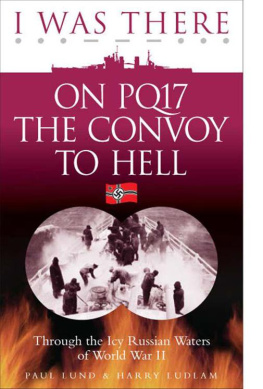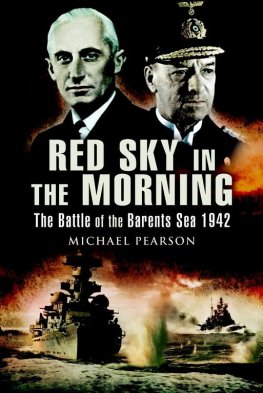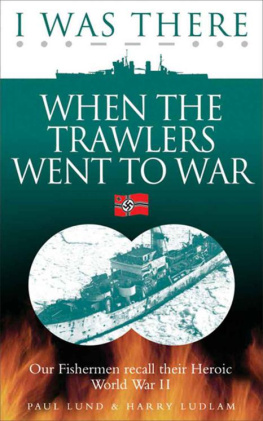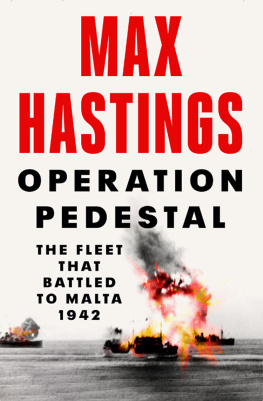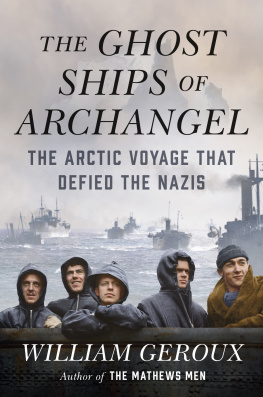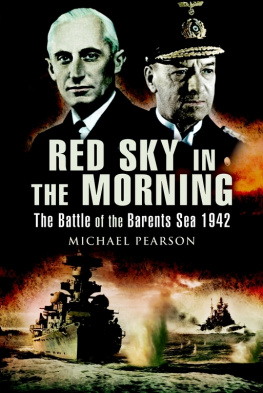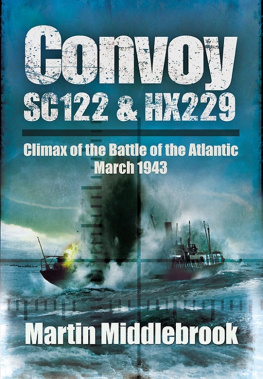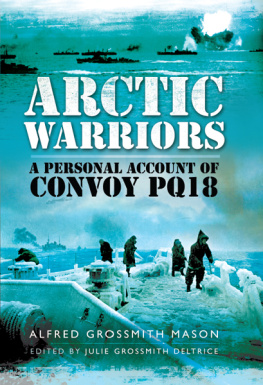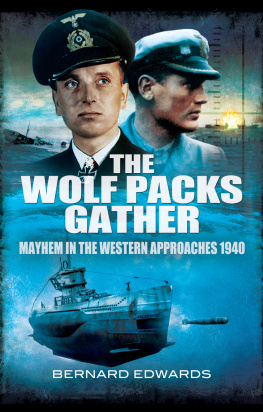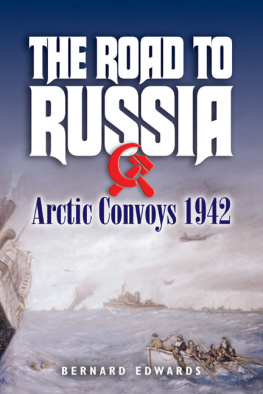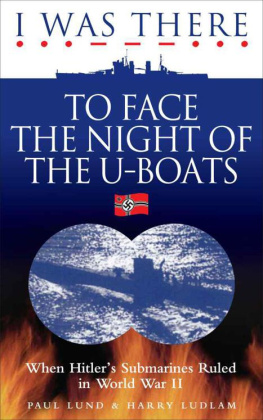
Table of Contents
Introduction
I have never been able to rejoice with my American friends on Independence Day, because July 4 is, to me, a day to hang my head in grief for all the men who lost their lives on Convoy PQ 17 and in shame at the recollection of one of the bleakest episodes in Royal Naval history, when the warships deserted the merchant ships and left them to their fate. For that, in simple terms, was what we were obliged to do.
Vice Admiral W D OBrien CB DSC
Commander Far East Fleet
Chapter 1
The Arctic Convoys

/>
'Hell below zero' they called it, the men who ran the convoys to north Russia. They had choicer descriptions, too, for the desolate Arctic regions that proved one of the most challenging arenas of the Second World War. Here half the battle was fought against the elements, and an icy sea could claim a man within minutes of immersion.
In the winter it was a fight against intense cold and long hours of darkness. Freezing fog was a constant companion until it was blown away by winds that turned sharply to howling gales. Ships heaved and rolled, forging their way through dangerous loose ice and icebergs. Icy spray lashed across them, freezing on decks and gun mountings. It whiplashed the lookouts' faces, turning them the colour of raw steak. With the gales came hail like tiny machine-gun bullets, and snow that piled up on deck and froze if it was not dug away quickly. Crews had to watch out constantly for ice forming: too heavy a build-up could cause a ship to capsize in rough weather.
In midsummer, when PQ 17 sailed, the Arctic could show a very different but still treacherous face. Around the coast of Iceland you encountered heavy seas, biting cold and dull grey skies, but as you headed north-east, passing near Jan Mayen Island, and then due east, steaming north or south of Bear Island, conditions improved. Here was a world where the sun shone brilliantly for 24 hours a day. You could feel it tanning you at 2 a.m., even with the temperature below zero but the enemy could see you for 24 hours a day.
There was still ice and fog, but in different forms. To the north was the ice barrier, dividing the blue sea from the dazzling expanse of ice that stretched away unbroken to the North Pole; in midsummer the distance from the ice edge to the Pole was about 700 miles. Huge icebergs sailed past majestically, like multi-coloured schooners glinting in the sun. Fog banks rose out of the sea and eerily engulfed you. Generally, however, it was a lighter, softer, friendlier fog than experienced in the grim winter months, and you were soon out of it and back in a world of cobalt blue sky and sea. For this was a part of the Arctic where the Gulf Stream made itself felt, causing great variations in sea temperature and sudden shifting fog banks.
The perpetual daylight made it difficult to remember whether it was 4 a.m. or 4 p.m., whether your next meal was going to be breakfast or supper. This feeling of unreality was increased by the heady thinness of the air and the unusual clarity of the atmosphere, which brought a strange, dream-like quality to everything. Even the dancing, sparkling waves seemed to have a hypnotic effect. Other ships seemed to spread themselves out into the shape of islands or elongate themselves into tall trees, all length and no breadth. Other ships seemed to sail upside down above the horizon on a sea in the sky. Then you remembered that mirages as vivid as any seen in the desert occurred in these regions.
This was the weird, lonely world convoy PQ 17 sailed into.
When Hitler invaded Russia on 22 June 1941, Stalin immediately appealed to Britain and America for war materials and supplies for his hard-pressed armies. A first convoy was sent to Russia in August. In September the long series of PQ convoys began, planned to sail at ten-day intervals. They did not happen, however, though they still kept to a heavy schedule.
On 7 July 1941, only a fortnight after Hitler marched on Russia, Iceland was occupied by American forces, so the PQ convoys sailed from there. They went up the west coast of Iceland, round to the north and east, past Jan Mayen Island and Bear Island, along the northern ice edge, as far as possible from enemy airfields in northern Norway. Then they travelled into the Barents Sea, down to the Kola Inlet and the port of Murmansk: 2,000 miles from Scapa Flow. Most ships went to Murmansk, the only Russian port that remained ice free all year. If the ice permitted, some sailed 400 miles further on, east to Archangel.
PQ 1, ten ships escorted by a cruiser and two destroyers, left Iceland for Archangel on 28 September 1941. In the words of someone who took part in it, the operation was 'a piece of cake'. More convoys followed at roughly fortnightly intervals. None were attacked and by the end of the year more than 50 merchantmen had steamed safely through.
In the early months of 1942, however, as successive convoys fought their way through winter gales and blizzards, enemy resistance slowly built up. Even so, when the 12 ships of PQ 12 sailed on 1 March, only one outward-bound merchantman and a destroyer had been lost.
From then on, losses mounted, though they were still small. PQ 12 lost one ship; the next convoy four ships; and PQ 14 one, though 16 vessels had to turn back because of ice. PQ 15, made up of 25 ships, which sailed in April, lost three merchantmen. The Navy's losses at this time also included two valuable cruisers, the Trinidad and the Edinburgh, both torpedoed.
Now it was the Arctic summer, with 24 hours of daylight. There was no darkness to give the slow-moving merchantmen and their escorts some protection against enemy attacks. As well as enemy planes and U-boats, the fast, immensely powerful battleship Tirpitz and her consorts, lurking in the Norwegian fjords, were a threat. The Tirpitz had already made one sortie: PQ 12 had narrowly escaped her.
Stalin was adamant that the convoys should continue without interruption, however, and President Roosevelt also believed they should go on; American merchant ships were now queueing up to join the convoys. Churchill had little option but to comply with the wishes of the other two leaders, so PQ 16 a total of 35 ships, the largest convoy yet sailed from Hvalfjord on 21 May. It had 17 close escorts, shadowed by four cruisers and three destroyers, which accompanied it as far as Bear Island. The battle fleet was to the rear, ready to intercept the Tirpitz if she put to sea. She did not, but during a very tough run to Murmansk, PQ 16 lost seven ships, six from heavy attacks by enemy aircraft.
Then it was the turn of PQ 17. After PQ 16's bitter experience, the question was: should PQ 17 sail or wait for a return of winter darkness? After the loss of the Trinidad and the Edinburgh no escorting cruisers could be risked beyond Bear Island, and no aircraft carrier spared for the run. There also remained the threat from the Tirpitz and other German heavy ships. Strong information had been received that the enemy intended to make an all-out assault on the next convoy.
Stalin, concerned only with his country's plight, insisted that the convoys should continue whatever the cost. Roosevelt concurred. Churchill was therefore forced to make a political decision, and the Admiralty, which had strongly objected to the convoy sailing in broad daylight, was obliged to follow the Government's wishes.
Next page
